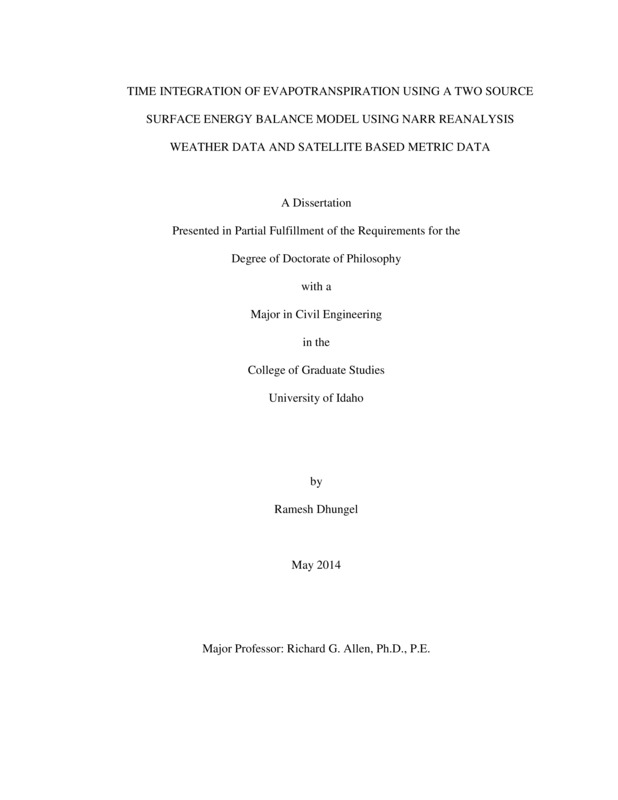TIME INTEGRATION OF EVAPOTRANSPIRATION USING A TWO SOURCE SURFACE ENERGY BALANCE MODEL USING NARR REANALYSIS WEATHER DATA AND SATELLITE BASED METRIC DATA
Dhungel, Ramesh. (2014). TIME INTEGRATION OF EVAPOTRANSPIRATION USING A TWO SOURCE SURFACE ENERGY BALANCE MODEL USING NARR REANALYSIS WEATHER DATA AND SATELLITE BASED METRIC DATA. Theses and Dissertations Collection, University of Idaho Library Digital Collections. https://www.lib.uidaho.edu/digital/etd/items/dhungel_idaho_0089d_10057.html
- Title:
- TIME INTEGRATION OF EVAPOTRANSPIRATION USING A TWO SOURCE SURFACE ENERGY BALANCE MODEL USING NARR REANALYSIS WEATHER DATA AND SATELLITE BASED METRIC DATA
- Author:
- Dhungel, Ramesh
- Date:
- 2014
- Keywords:
- Evapotranspiration GIS/Remote Sensing METRIC NARR Reanalysis Soil water balance Surface Energy Balance
- Program:
- Civil Engineering
- Subject Category:
- Engineering; Civil engineering; Water resources management
- Abstract:
-
A backward averaged two source accelerated numerical solution (BATANS) of surface energy fluxes was developed that utilizes satellite-based Mapping Evapotranspiration at High Resolution using Internalized Calibration (METRIC) data and NARR reanalysis weather data. BATANS simulates surface energy fluxes and surface temperature for surface energy balance when no thermal based surface temperature is available. BATANS was able to partition both satellite based Metric ET at the time of satellite overpass and time-integrate ET between the satellite overpass dates. In addition, BATANS was able to time integrate ET every three hours with the partitioned surface energy fluxes. Partitioned ET on the satellite overpass day was used to estimate soil surface moisture and root zone moisture based on the soil and canopy resistances. Estimated soil moisture at the start of the satellite overpass was used in soil water balance while time integrating ET. A Jarvis type canopy resistance was utilized by BATANS to estimate the canopy transpiration. An irrigation module was developed to simulate irrigation in agricultural lands when soil moisture falls below a set threshold. The time integrated ET was calibrated and validated using METRIC ET at the start of simulation period and at the next satellite overpass date. Any difference between the simulated and METRIC ET at the end of the simulation period was adjusted linearly assuming that error grows at the same rate over the time. Result showed good agreement between simulated and Metric derived surface energy fluxes and surface temperature in most of the agricultural lands. However, the agreement in the surface temperature was not as good in desert and dry areas. Daily time integrated ET from BATANS between the satellite overpass was also compared to reference ET from AgriMet weather station which showed a reasonable trend. The simple FAO-56 soil water balance model was compared to the advance numerical solution based Hydrus-1D model to validate the soil water balance between the satellite overpasses. Results showed that both models estimated similar soil water balance.
- Description:
- doctoral, Ph.D., Civil Engineering -- University of Idaho - College of Graduate Studies, 2014
- Major Professor:
- Allen, Richard G.
- Committee:
- Trezza, Ricardo; Humes, Karen; Fiedler, Fritz
- Defense Date:
- 2014
- Identifier:
- Dhungel_idaho_0089D_10057
- Type:
- Text
- Format Original:
- Format:
- application/pdf
- Rights:
- In Copyright - Educational Use Permitted. For more information, please contact University of Idaho Library Special Collections and Archives Department at libspec@uidaho.edu.
- Standardized Rights:
- http://rightsstatements.org/vocab/InC-EDU/1.0/

